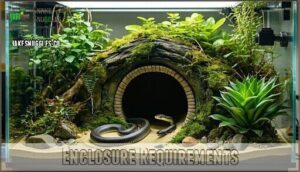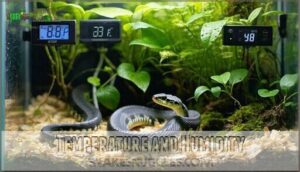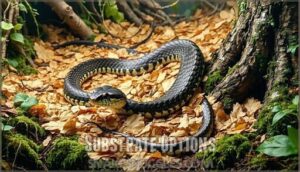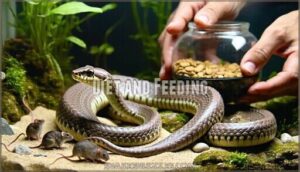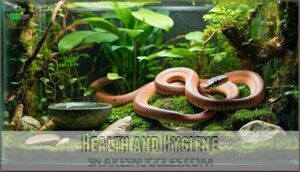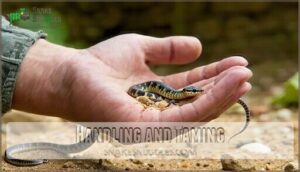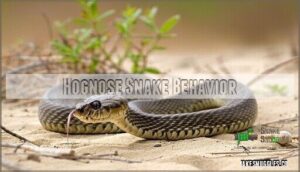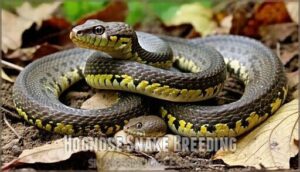This site is supported by our readers. We may earn a commission, at no cost to you, if you purchase through links.
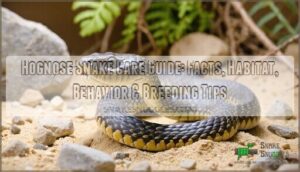
These snakes are famous for their upturned snouts and Oscar-worthy “playing dead” routine when startled.
Native to North America, hognose snakes grow to about two feet and can live over a decade with proper care.
They love to burrow, so give them a roomy enclosure with loose substrate.
You’ll want to keep their habitat warm and slightly humid, and feed them mostly mice.
Their gentle, quirky personalities make them popular pets.
Stick around—there’s more to these snakes than just dramatic flair and a funny nose!
Table Of Contents
- Key Takeaways
- Hognose Snake Overview
- Hognose Snake Habitat
- Hognose Snake Care
- Hognose Snake Behavior
- Hognose Snake Breeding
- Frequently Asked Questions (FAQs)
- Are hognose snakes venomous?
- What is a western hognose snake?
- What is an eastern hognose snake?
- How do hognose snakes differ from other snakes?
- Are hognose snakes fear free?
- What is a southern hognose snake?
- What if a hognose snake bites you?
- Why are hognose snakes so aggressive?
- Is it safe to hold a hognose snake?
- Is a hognose snake a good pet?
- Conclusion
Key Takeaways
- You’ll recognize hognose snakes by their upturned snouts and dramatic defensive behaviors, like playing dead and hissing.
- You need to provide a secure, roomy enclosure with loose substrate for burrowing, plus proper heat and humidity.
- Feed them appropriately sized thawed rodents once a week, and keep their habitat clean to prevent health issues.
- Handle your hognose gently and regularly to build trust—they rarely bite and make quirky, entertaining pets.
Hognose Snake Overview
You’ll discover that hognose snakes are fascinating reptiles belonging to the Colubridae family, known for their distinctive upturned snouts and dramatic defensive behaviors.
Hognose snakes captivate with their upturned snouts and over-the-top defensive antics—nature’s little drama queens of the reptile world.
These non-venomous snakes come in 14 species across three genera, with most reaching 15-40 inches in length and displaying remarkable adaptations for their burrowing lifestyle, which includes their ability to live in various environments, making them fascinating creatures.
Species Classification
Understanding hognose snake taxonomy begins with recognizing the Genus Heterodon within the Colubridae family.
Species identification involves three primary genera: Heterodon (North American varieties), Leioheterodon (Madagascar species), and Lystrophis (South American types).
Taxonomy debate continues regarding subspecies classifications, particularly within Western hognose varieties. Morphological variation across these snake species creates challenges for proper identification.
Current conservation status varies by region, with some populations facing habitat pressures. This snake taxonomy encompasses fourteen recognized species displaying the characteristic upturned snout adaptation.
They’re named for their distinct upturned snout used for digging.
Physical Attributes
Hognose snakes captivate reptile enthusiasts with their unmistakable upturned snout morphology and remarkable color variations.
Their quirky snouts and endless color patterns make hognose snakes a favorite among reptile lovers everywhere.
Their distinctive snake morphology includes:
- Scale patterns featuring rough, keeled textures across their stocky frame
- Body size ranging from compact 14-inch males to robust 35-inch females
- Snake skin displaying over 60 morphs from sandy browns to striking albinos
Sexual dimorphism is pronounced—females substantially outsize males.
Their broad heads and thick bodies make identification straightforward among snake size categories.
Lifespan and Size
When caring for your hognose snake, understanding their lifespan and size helps you plan for long-term commitment.
These remarkable reptiles typically live 10-18 years in captivity with proper care, though some exceptional individuals reach their early twenties.
You can even find these snakes, including the Western Hognose variety, at some pet stores.
Sexual dimorphism creates noticeable size variation between males and females.
Your snake’s growth rate will be fastest during their first two years before gradually slowing.
| Characteristic | Males | Females |
|---|---|---|
| Average Lifespan | 10-15 years | 12-18 years |
| Adult Length | 14-20 inches | 18-24 inches |
| Maximum Size | 24 inches | 30+ inches |
| Adult Weight | 50-150 grams | 150-400 grams |
Hognose Snake Habitat
Creating a proper habitat for your hognose snake sets the foundation for a healthy, thriving pet that’ll display its natural behaviors.
You’ll need to balance space, temperature, and substrate choices to mimic their wild environment while ensuring easy maintenance.
Enclosure Requirements
For your hognose snake’s home, prioritize a secure 20-gallon tank with excellent floor space over height. Tank size matters—adults need room to stretch and explore.
Install hiding spots on both warm and cool sides for security. Add enrichment ideas like artificial plants, branches, or textured rocks to create an engaging snake habitat.
Make certain your enclosure setup includes a tight-fitting lid since these escape artists are surprisingly clever. Lighting needs are minimal, though UVB can enhance their natural behaviors.
Many owners find it easy to purchase a suitable tank online. Focus on substrate safety by avoiding loose materials that could cause impaction during feeding.
Temperature and Humidity
Perfect temperature regulation keeps your hognose snake thriving. Create a basking temperature of 85-90°F and maintain the cool side at 70°F for an ideal temperature gradient. Humidity levels should stay between 40-70% for healthy conditions.
Monitoring tools and seasonal adjustments guarantee consistent humidity control. Use digital thermometers on both warm and cool sides, install hygrometers to track humidity accurately, employ thermostats for automatic temperature control, and adjust settings seasonally as room temperatures change.
- Use digital thermometers on both warm and cool sides
- Install hygrometers to track humidity accurately
- Employ thermostats for automatic temperature control
- Adjust settings seasonally as room temperatures change
- Check readings daily during initial setup
Substrate Options
Selecting appropriate substrate transforms your hognose snake’s enclosure into a comfortable home.
These fossorial reptiles spend most time burrowing, making substrate choice essential for natural behavior.
| Substrate Type | Pros & Cons |
|---|---|
| Aspen shavings | Holds tunnels well, easy cleaning; limited moisture retention |
| Soil mixes | Mimics natural habitat, supports bioactive setups; requires proper ratios |
| Newspaper substrate | Sterile, cheap for quarantine; prevents natural burrowing behavior |
| Sand dangers | Looks natural; causes substrate ingestion, compaction risks |
Your snake care routine should include 3-5 inches depth for proper tunneling.
Hognose snakes exhibit a fossorial lifestyle, so they need a substrate that facilitates digging.
Avoid cedar or pine—their oils harm reptiles.
Consider reptile supplies like topsoil-sand mixtures (70/30 ratio) for ideal results.
Hognose Snake Care
Caring for your hognose snake properly guarantees a healthy, thriving pet that can live 15-20 years in captivity.
You’ll need to master three essential areas: feeding schedules, health monitoring, and safe handling techniques.
Diet and Feeding
Feeding your hognose snake involves offering appropriately-sized thawed rodents that match your snake’s body width. Adult hognose snakes thrive on weekly meals, while juveniles require more frequent feeding every 5-7 days.
Their captive diet primarily consists of mice, though wild hognose snakes are famous for toad consumption. If your snake refuses meals, try scenting techniques or switching prey types. Quality supplementation isn’t typically necessary with whole prey items.
Many owners buy pre-killed rodents online for convenience.
- Prey size matters: Too large can cause regurgitation, too small won’t satisfy nutritional needs
- Consistency builds trust: Regular feeding schedules help your snake feel secure and reduce stress
- Patience pays off: Some hognose snakes are notoriously picky eaters, but persistence usually wins
- Feed appropriately-sized prey once weekly.
- Use scenting techniques for reluctant feeders.
- Adjust feeding frequency as snakes grow.
Health and Hygiene
In terms of snake health, a clean enclosure is your best friend.
Respiratory infections, mouth rot, and fungal infections are common snake diseases in hognose snakes, often linked to poor hygiene or incorrect humidity.
Spot-clean feces and shed skin two to three times a week, and deep-clean the enclosure every month to keep snake mites and parasites at bay.
Keep humidity between 40–60% to avoid shedding problems—nothing ruins a snake’s day like a stuck shed.
For parasite prevention, always quarantine new arrivals and use only clean, captive-bred feeders.
If you spot wheezing or swelling, don’t hesitate to call a snake veterinarian.
Consistent care keeps your hognose healthy and happy.
Regular cleaning can also help prevent snake mite infestations.
Handling and Taming
One key to safe handling and taming techniques with your hognose snake is patience—think of it as teaching a shy friend to dance.
Move slowly to reduce stress, as sudden motions can trigger defensive behavior. Regular, gentle interaction builds trust, lowers bite risk, and helps your snake’s temperament shine.
Remember, frequent handling keeps your hognose docile and curious. To further enrich their environment, consider that they need at least 4 inches of substrate for burrowing.
Hognose Snake Behavior
You’ll notice hognose snakes are famous for their dramatic defensive displays, including head flattening, loud hissing, and even pretending to be dead.
Understanding these unique behaviors helps you provide a safe, low-stress environment for your snake and keeps you from falling for their best Oscar-worthy performances.
Defensive Mechanisms
Whether you’re new to snakes or a seasoned keeper, hognose defensive behavior is pure drama.
Their snake defense mechanisms include:
- Bluffing Tactics: Flattening their necks in a classic hooding behavior, paired with a loud hissing defense—think cobra cosplay.
- Playing Dead: Expert death feigning, complete with rolling over, tongue out, and limp posture.
- Musky Odor: When all else fails, they’ll release a musky odor to deter predators—no Oscar, but effective!
Social Interaction
A hognose’s social life is mostly a solo act. They prefer their own company, making Captive Cohabitation risky due to unpredictable snake behavior and defensive behaviors.
Human Interaction, though, can be rewarding—these snakes often tolerate gentle handling. Don’t expect group chats; their Snake Communication is subtle.
Here’s a quick look at their traits:
| Snake Trait | Human Interaction | Interspecies Interactions |
|---|---|---|
| Solitary Nature | Calm | Rare |
| Playing Dead | Unlikely | Defense |
| Defensive Behaviors | Mild | Common |
| Communication | Subtle | Minimal |
| Cohabitation Risk | Low | High |
Burrowing and Exploration
After learning about their social quirks, let’s talk about what really gets a hognose snake moving—burrowing and exploration.
Their unique snout adaptation is perfect for digging techniques in soft substrates.
Give them aspen shavings or soil to satisfy their substrate preference.
Habitat exploration keeps them curious, while burrowing benefits their health.
Watching your snake reshape its enclosure is pure entertainment and a sign of thriving snake behavior.
Hognose Snake Breeding
If you’re interested in breeding hognose snakes, you’ll need to understand their specific mating habits, egg-laying process, and hatchling care.
With the right preparation, you can help these fascinating reptiles reproduce successfully—just don’t expect them to help with the babysitting.
Mating and Reproduction
During the breeding season, snake breeding kicks off with unique courtship rituals—think gentle nudges and tail wraps.
Once your hognose reaches sexual maturity, pair healthy snakes for the best reproductive health.
Females can store sperm, leading to flexible egglaying. Expect a clutch size of 2–30 eggs about 7–9 weeks after mating.
Ideal breeding temperatures impact successful mating behaviors.
- Courtship Rituals
- Sexual Maturity
- Clutch Size
- Reproductive Health
- Egglaying
Egg Incubation
Once your snake’s egg-laying is done, set your incubator to 80–84°F and keep humidity close to 100%.
Use vermiculite or perlite for Incubation Substrates—just damp, not soggy.
Monitor with Egg Candling and check for dents or mold.
Stable Incubation Temperature and Humidity Control mean better Hatching Success.
Here’s a quick cheat sheet:
| Factor | Ideal Range |
|---|---|
| Temperature | 80–84°F |
| Humidity | ~100% |
| Substrate | Vermiculite |
| Incubation Time | 48–60 days |
| Monitoring Tool | Egg Candling |
Hatchling Care and Feeding
After eggs hatch, set your hatchlings up for success with a well-sized enclosure and fresh water for proper hydration needs.
Offer their first meals—tiny pinkies—after their initial shed. If you spot shedding issues, bump up humidity.
For picky eaters, scent prey with tuna. Stick to a regular supplementation schedule to support healthy growth and ideal snake care.
Frequently Asked Questions (FAQs)
Are hognose snakes venomous?
Don’t let the “wolf in sheep’s clothing” act fool you—hognose snakes have mild venom in their rear fangs, but it’s harmless to humans.
You might get a bluff or hiss, but you’re perfectly safe.
What is a western hognose snake?
You’ll spot a western hognose by its upturned nose, used for digging in sandy soil.
Native to North America, it’s nonvenomous, eats mostly toads, and puts on dramatic bluffing displays when feeling threatened.
What is an eastern hognose snake?
You’ll spot the eastern hognose by its upturned snout and dramatic flair—flattening its neck, hissing, and even playing dead.
Native to eastern North America, it’s nonvenomous, mostly eats toads, and rarely bites.
How do hognose snakes differ from other snakes?
Ever wonder if a snake could fake its own death?
You’ll find hognose snakes do just that, plus they sport upturned snouts for digging, rarely bite, and rely on bluffing—far different from most other snakes.
Are hognose snakes fear free?
You won’t find a totally “fear free” animal, and hognose snakes are no exception.
When threatened, they’ll bluff, hiss, or play dead, but rarely bite.
They’re more dramatic than dangerous—think of them as the actors of the snake world.
What is a southern hognose snake?
Imagine a snake with a nose like a tiny plow—you’re looking at the southern hognose.
This small, stout reptile lives in the southeastern U.S., loves sandy soils, and rarely bites, preferring dramatic bluffing displays.
What if a hognose snake bites you?
If you get bitten, don’t panic—hognose snakes have mild, non-lethal venom and rarely cause serious reactions.
Just wash the bite with soap and water, watch for swelling, and seek medical help if you feel unwell.
Why are hognose snakes so aggressive?
They act like drama queens at a talent show—flattening heads, hissing, and even playing dead—not out of true aggression, but to scare off threats.
You’ll rarely get bitten; their bluffs are all bark, no bite.
Is it safe to hold a hognose snake?
Yes, you can safely hold one, as they rarely bite and prefer bluffing to real aggression.
Just remember, they might hiss or play dead if startled—think of it as their version of dramatic acting!
Is a hognose snake a good pet?
Like a quirky roommate, this reptile’s dramatic flair and low-maintenance needs make it a solid choice for many.
You’ll need secure housing, proper heat, and a steady diet, but it rarely bites and offers fascinating behaviors.
Conclusion
Much like the hognose snake’s winding path through soil, your journey as a keeper weaves together science, patience, and curiosity.
By providing the right habitat, diet, and care, you’ll support their health and unique behaviors.
Remember, these snakes thrive with consistent routines and gentle handling. Whether you’re drawn in by their dramatic defense or quirky charm, caring for a hognose snake is a rewarding experience, blending responsibility with the intrigue of observing nature up close.

